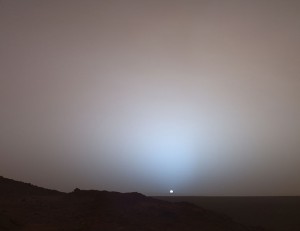FRIDAY, 18 JUNE 2010
Findings from 'Spirit', one of NASA's Mars Rovers, hints at a warm, wet climate on Mars some four billion years ago. This hypothesis, although first postulated decades ago, has now been lent credence by dedicated analysis of the Rover's spectrometer data over a period of several years. The international research team lead by Richard Morris of the NASA Johnson Space Center have published their results in Science [1].Conditions ideal for life could only have been present if Mars had previously contained a significant volume of water (with a relatively neutral pH) and higher levels of carbon in an altogether warm, moist and dense atmosphere. Perhaps the best evidence for this previously carbon-dense environment would be rock formations with high carbonate mineral content, as such outcrops could only occur in moist climates, while the aqueous processes of carbonate formation in rocks would further suggest pH neutrality.
After analyzing the Mossbauer spectrometer on the Rover and corroborating these findings with further evidence from an alpha particle X-ray spectrometer and a thermal emission spectrometer, the researchers discovered that a rocky outcrop, called 'Comanche', contains a considerable amount of carbonates. The rocks, which consist of approximately 20 percent carbonates, are mostly composed of magnesium iron carbonate and their formation indicates an environment hospitable to life. Previously, the discovery of acidic surface waters on Mars was interpreted to suggest the implausibility of such an environment.
The study parallels the 1990's discovery of carbonate content in the Mars meteorite, dubbed ALH84001, that landed in Antarctica in 1986. Conclusions similar to the Comanche findings were drawn regarding a moist, carbon-rich environment with near neutral pH, implying traces of biological potentiality. It also coincides with a study published this week in Nature Geoscience, which suggests that an analysis of Martian delta deposits and distribution, combined with previous topographic analyses of the planet, indicates a vast ocean covering the northern hemisphere of Mars around 3.5 billion years ago.
Written by Taylor Burns

